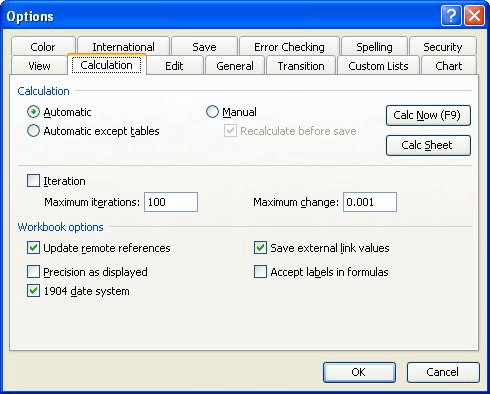Please Note: This article is written for users of the following Microsoft Excel versions: 97, 2000, 2002, and 2003. If you are using a later version (Excel 2007 or later), this tip may not work for you. For a version of this tip written specifically for later versions of Excel, click here: Only Showing the Maximum of Multiple Iterations.
Written by Allen Wyatt (last updated November 9, 2024)
This tip applies to Excel 97, 2000, 2002, and 2003
Mike has three cells (A1:A3) that show results of calculations. He needs a way to determine the maximum value that has ever appeared in any of these cells, and have that value stored in cell E5. He knows how to get the maximum out of the three, but when he recalculates the worksheet, if the values in A1:A3 are less than the maximum value in E5 (based on previous determinations of the maximum in A1:A3), then E5 should not change. In other words, E5 should only change if whatever is in A1:A3 is greater than what is in E5. Mike isn't sure how to perform such a calculation.
There are two ways you can solve this issue. The first is to create a simple formula that would be placed in cell E5:
=MAX(A1:A3,E5)
The MAX function examines the various values it references and then returns the maximum out of them—exactly what is wanted. However, since this formula is being placed in cell E5 and it also references E5, it will return an error. This is because the formula creates a circular reference. Excel can handle those, but you need to make a small configuration change to do it:

Figure 1. The Calculation tab of the Options dialog box.
Now Excel will handle circular references, such as the simple formula you've put in cell E5.
The second approach is to use a macro to perform the calculation. This approach may be preferred because you may not want (for some reason) to enable circular references in your workbook. The following is actually an event handler, added to the code for the worksheet. (Easiest method: Right-click on the sheet tab, display the code window from the resulting Context menu, and add the macro to that code window.)
Private Sub Worksheet_Calculate()
Dim dMax As Double
dMax = Application.WorksheetFunction.Max(Range("A1:A3"))
If dMax > Range("E5") Then
Application.EnableEvents = False
Range("E5") = dMax
Application.EnableEvents = True
End If
End Sub
The macro is triggered every time the worksheet is recalculated. It grabs the maximum of A1:A3 and compares it to what is in E5. Only if it is larger is that value then placed into E5.
Note:
ExcelTips is your source for cost-effective Microsoft Excel training. This tip (10915) applies to Microsoft Excel 97, 2000, 2002, and 2003. You can find a version of this tip for the ribbon interface of Excel (Excel 2007 and later) here: Only Showing the Maximum of Multiple Iterations.

Program Successfully in Excel! This guide will provide you with all the information you need to automate any task in Excel and save time and effort. Learn how to extend Excel's functionality with VBA to create solutions not possible with the standard features. Includes latest information for Excel 2024 and Microsoft 365. Check out Mastering Excel VBA Programming today!
When working with data taken from the real world, you often have to determine which certain conditions were met, such as ...
Discover MoreDo you see some small rectangular boxes appearing in your formula results? It could be because Excel is substituting that ...
Discover MoreIf you have a range of values that can be either positive or negative, you might wonder how to determine the largest ...
Discover MoreFREE SERVICE: Get tips like this every week in ExcelTips, a free productivity newsletter. Enter your address and click "Subscribe."
There are currently no comments for this tip. (Be the first to leave your comment—just use the simple form above!)
Got a version of Excel that uses the menu interface (Excel 97, Excel 2000, Excel 2002, or Excel 2003)? This site is for you! If you use a later version of Excel, visit our ExcelTips site focusing on the ribbon interface.
FREE SERVICE: Get tips like this every week in ExcelTips, a free productivity newsletter. Enter your address and click "Subscribe."
Copyright © 2025 Sharon Parq Associates, Inc.
Comments